Business Environment Report - Tesco Analysis, LO1-LO4, 2024
VerifiedAdded on 2020/07/22
|21
|6019
|79
Report
AI Summary
This report provides a comprehensive analysis of Tesco's business environment, examining its organizational structure, various functions, and the impact of both internal and external factors. The report begins with an introduction to the business environment and its significance, followed by an in-depth exploration of different organizational types, including public, private, and voluntary sectors, along with their respective legal structures. It then delves into the size and scope of these organizations, using examples like Transport for London, Iceland, and various NGOs. The report further analyzes the relationship between different organizational functions, such as sales and marketing, finance, human resources, and administration, within the context of Tesco. It also assesses the positive and negative impacts of the macro environment and conducts an internal and external analysis of Tesco, incorporating a SWOT analysis to identify strengths, weaknesses, opportunities, and threats. The report concludes by examining the interrelation of strengths and weaknesses with external macro factors, providing a holistic understanding of Tesco's position within the broader business landscape.
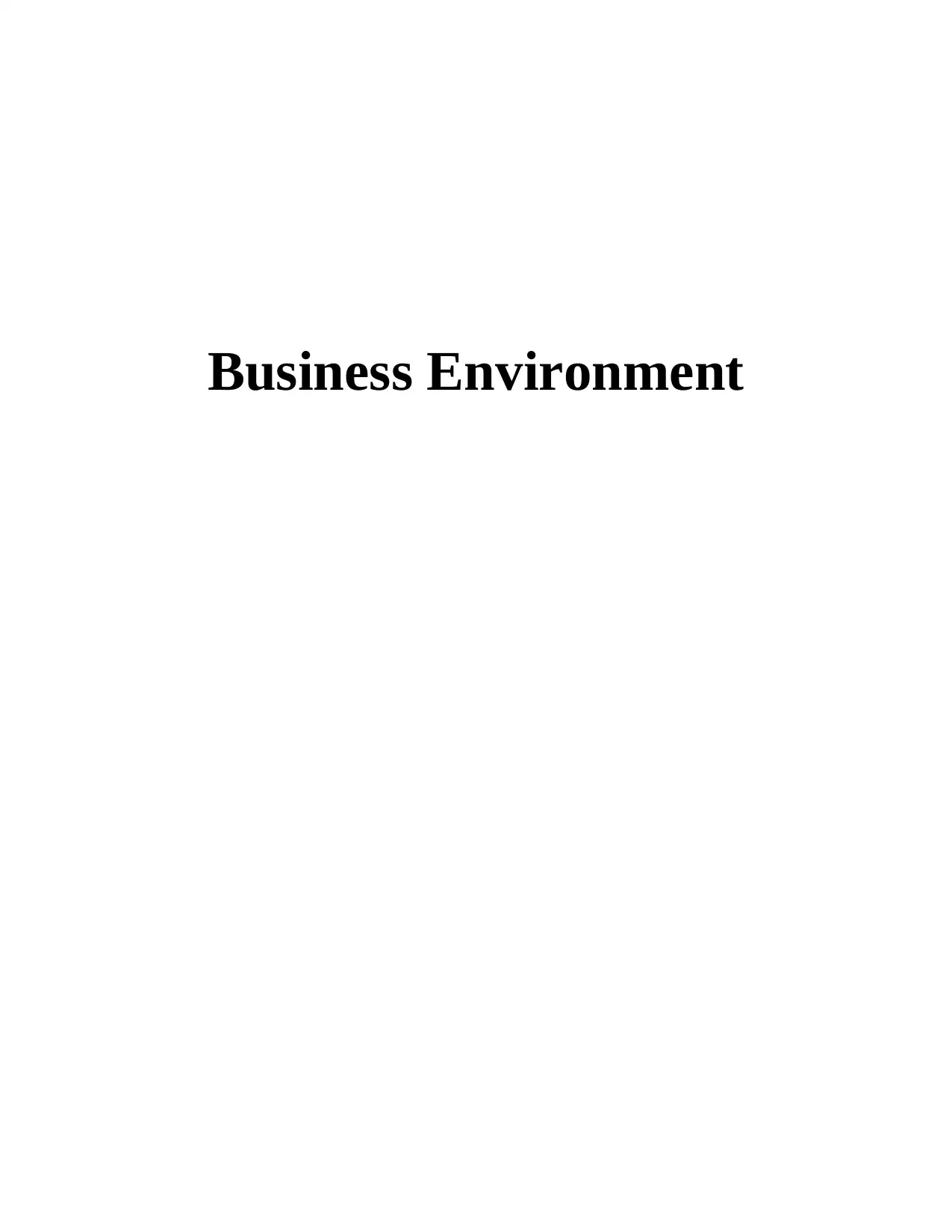
Business Environment
Paraphrase This Document
Need a fresh take? Get an instant paraphrase of this document with our AI Paraphraser
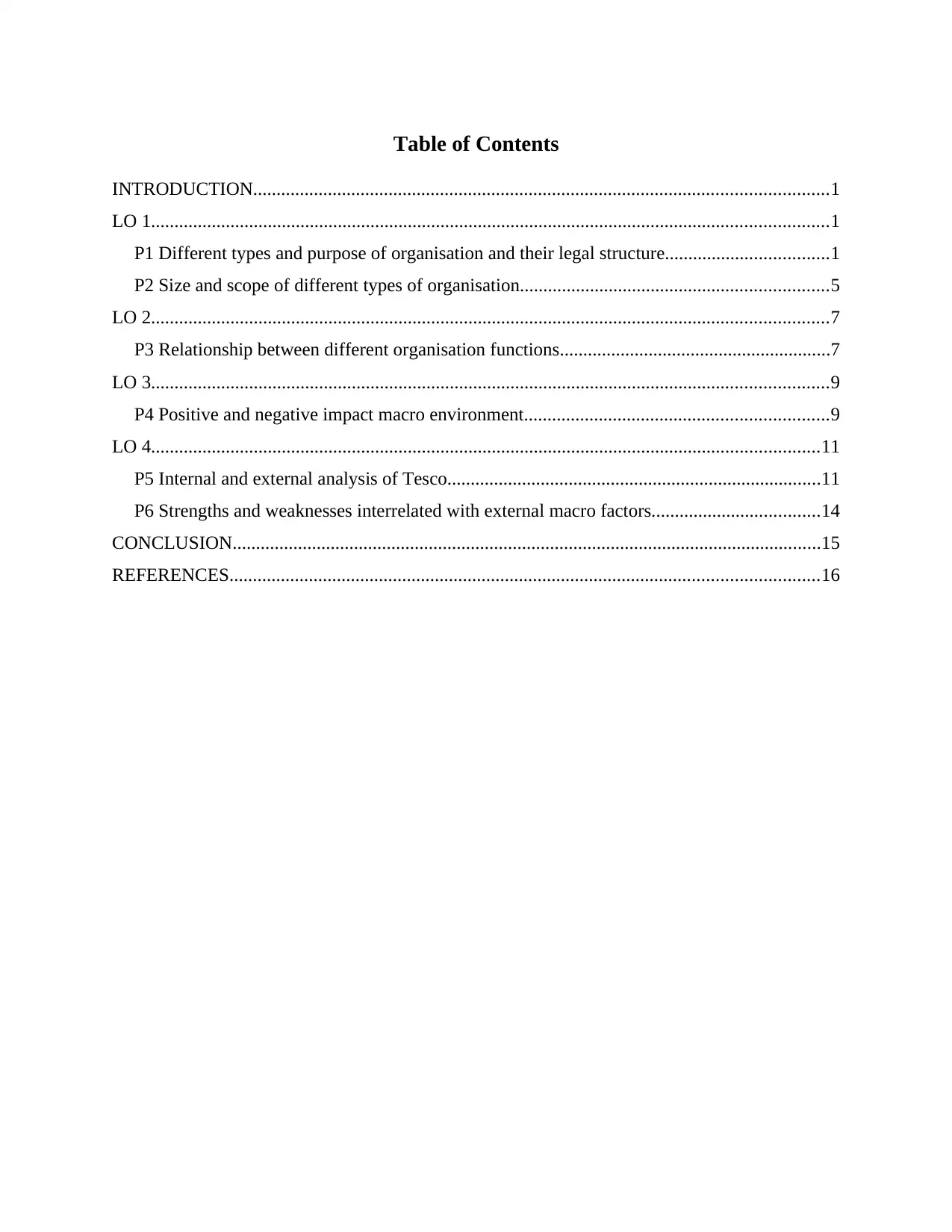
Table of Contents
INTRODUCTION...........................................................................................................................1
LO 1.................................................................................................................................................1
P1 Different types and purpose of organisation and their legal structure...................................1
P2 Size and scope of different types of organisation..................................................................5
LO 2.................................................................................................................................................7
P3 Relationship between different organisation functions..........................................................7
LO 3.................................................................................................................................................9
P4 Positive and negative impact macro environment.................................................................9
LO 4...............................................................................................................................................11
P5 Internal and external analysis of Tesco................................................................................11
P6 Strengths and weaknesses interrelated with external macro factors....................................14
CONCLUSION..............................................................................................................................15
REFERENCES..............................................................................................................................16
INTRODUCTION...........................................................................................................................1
LO 1.................................................................................................................................................1
P1 Different types and purpose of organisation and their legal structure...................................1
P2 Size and scope of different types of organisation..................................................................5
LO 2.................................................................................................................................................7
P3 Relationship between different organisation functions..........................................................7
LO 3.................................................................................................................................................9
P4 Positive and negative impact macro environment.................................................................9
LO 4...............................................................................................................................................11
P5 Internal and external analysis of Tesco................................................................................11
P6 Strengths and weaknesses interrelated with external macro factors....................................14
CONCLUSION..............................................................................................................................15
REFERENCES..............................................................................................................................16
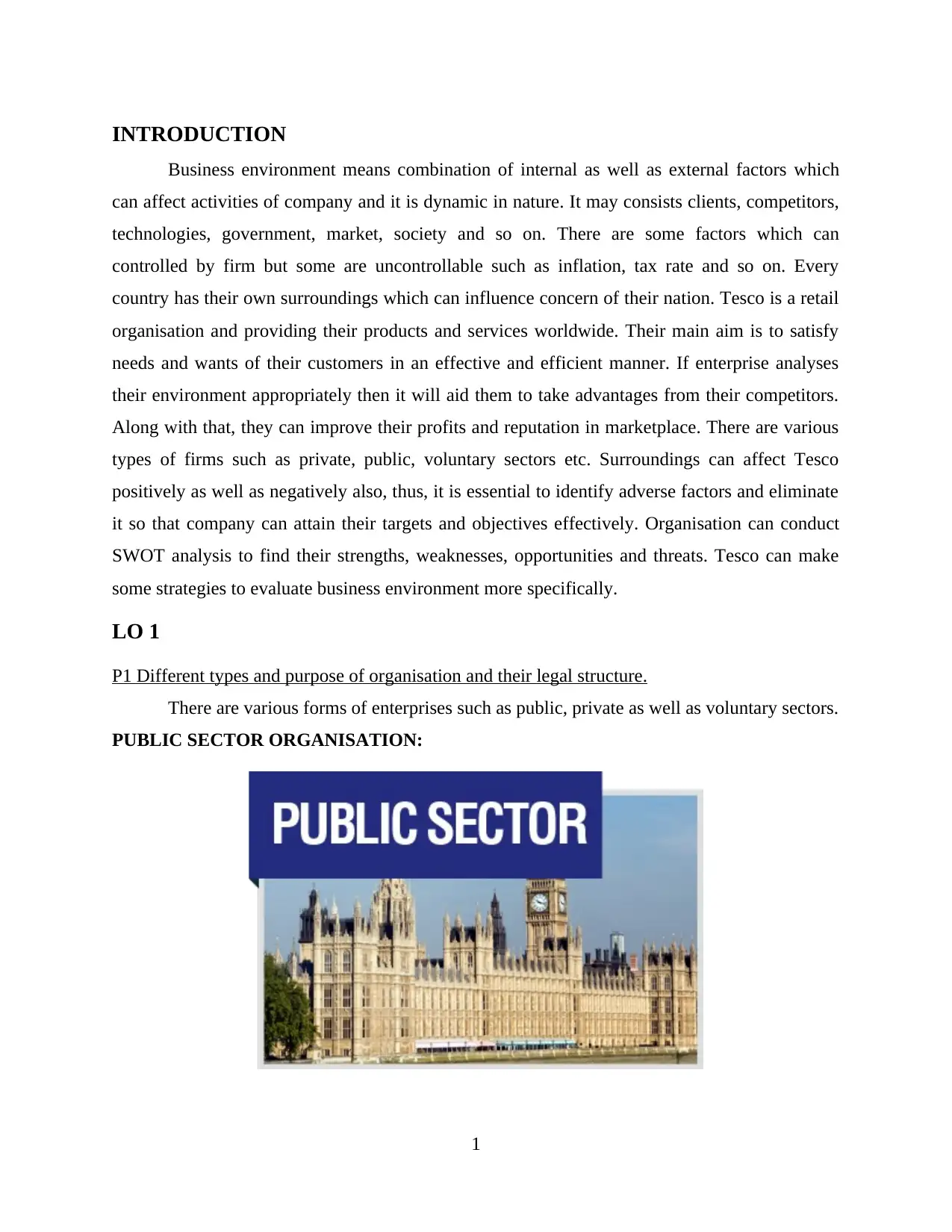
INTRODUCTION
Business environment means combination of internal as well as external factors which
can affect activities of company and it is dynamic in nature. It may consists clients, competitors,
technologies, government, market, society and so on. There are some factors which can
controlled by firm but some are uncontrollable such as inflation, tax rate and so on. Every
country has their own surroundings which can influence concern of their nation. Tesco is a retail
organisation and providing their products and services worldwide. Their main aim is to satisfy
needs and wants of their customers in an effective and efficient manner. If enterprise analyses
their environment appropriately then it will aid them to take advantages from their competitors.
Along with that, they can improve their profits and reputation in marketplace. There are various
types of firms such as private, public, voluntary sectors etc. Surroundings can affect Tesco
positively as well as negatively also, thus, it is essential to identify adverse factors and eliminate
it so that company can attain their targets and objectives effectively. Organisation can conduct
SWOT analysis to find their strengths, weaknesses, opportunities and threats. Tesco can make
some strategies to evaluate business environment more specifically.
LO 1
P1 Different types and purpose of organisation and their legal structure.
There are various forms of enterprises such as public, private as well as voluntary sectors.
PUBLIC SECTOR ORGANISATION:
1
Business environment means combination of internal as well as external factors which
can affect activities of company and it is dynamic in nature. It may consists clients, competitors,
technologies, government, market, society and so on. There are some factors which can
controlled by firm but some are uncontrollable such as inflation, tax rate and so on. Every
country has their own surroundings which can influence concern of their nation. Tesco is a retail
organisation and providing their products and services worldwide. Their main aim is to satisfy
needs and wants of their customers in an effective and efficient manner. If enterprise analyses
their environment appropriately then it will aid them to take advantages from their competitors.
Along with that, they can improve their profits and reputation in marketplace. There are various
types of firms such as private, public, voluntary sectors etc. Surroundings can affect Tesco
positively as well as negatively also, thus, it is essential to identify adverse factors and eliminate
it so that company can attain their targets and objectives effectively. Organisation can conduct
SWOT analysis to find their strengths, weaknesses, opportunities and threats. Tesco can make
some strategies to evaluate business environment more specifically.
LO 1
P1 Different types and purpose of organisation and their legal structure.
There are various forms of enterprises such as public, private as well as voluntary sectors.
PUBLIC SECTOR ORGANISATION:
1
⊘ This is a preview!⊘
Do you want full access?
Subscribe today to unlock all pages.

Trusted by 1+ million students worldwide
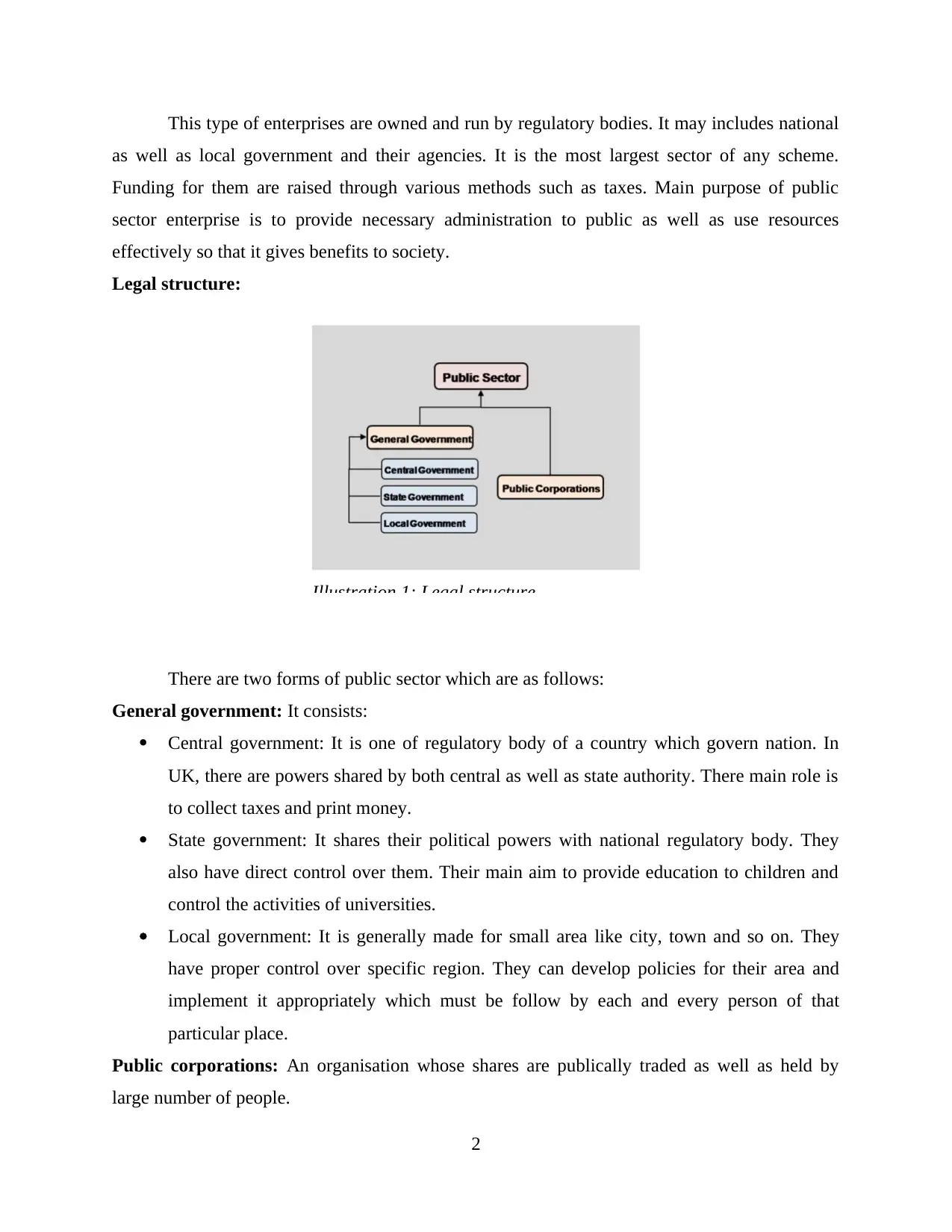
This type of enterprises are owned and run by regulatory bodies. It may includes national
as well as local government and their agencies. It is the most largest sector of any scheme.
Funding for them are raised through various methods such as taxes. Main purpose of public
sector enterprise is to provide necessary administration to public as well as use resources
effectively so that it gives benefits to society.
Legal structure:
There are two forms of public sector which are as follows:
General government: It consists:
Central government: It is one of regulatory body of a country which govern nation. In
UK, there are powers shared by both central as well as state authority. There main role is
to collect taxes and print money.
State government: It shares their political powers with national regulatory body. They
also have direct control over them. Their main aim to provide education to children and
control the activities of universities.
Local government: It is generally made for small area like city, town and so on. They
have proper control over specific region. They can develop policies for their area and
implement it appropriately which must be follow by each and every person of that
particular place.
Public corporations: An organisation whose shares are publically traded as well as held by
large number of people.
2
Illustration 1: Legal structure
as well as local government and their agencies. It is the most largest sector of any scheme.
Funding for them are raised through various methods such as taxes. Main purpose of public
sector enterprise is to provide necessary administration to public as well as use resources
effectively so that it gives benefits to society.
Legal structure:
There are two forms of public sector which are as follows:
General government: It consists:
Central government: It is one of regulatory body of a country which govern nation. In
UK, there are powers shared by both central as well as state authority. There main role is
to collect taxes and print money.
State government: It shares their political powers with national regulatory body. They
also have direct control over them. Their main aim to provide education to children and
control the activities of universities.
Local government: It is generally made for small area like city, town and so on. They
have proper control over specific region. They can develop policies for their area and
implement it appropriately which must be follow by each and every person of that
particular place.
Public corporations: An organisation whose shares are publically traded as well as held by
large number of people.
2
Illustration 1: Legal structure
Paraphrase This Document
Need a fresh take? Get an instant paraphrase of this document with our AI Paraphraser
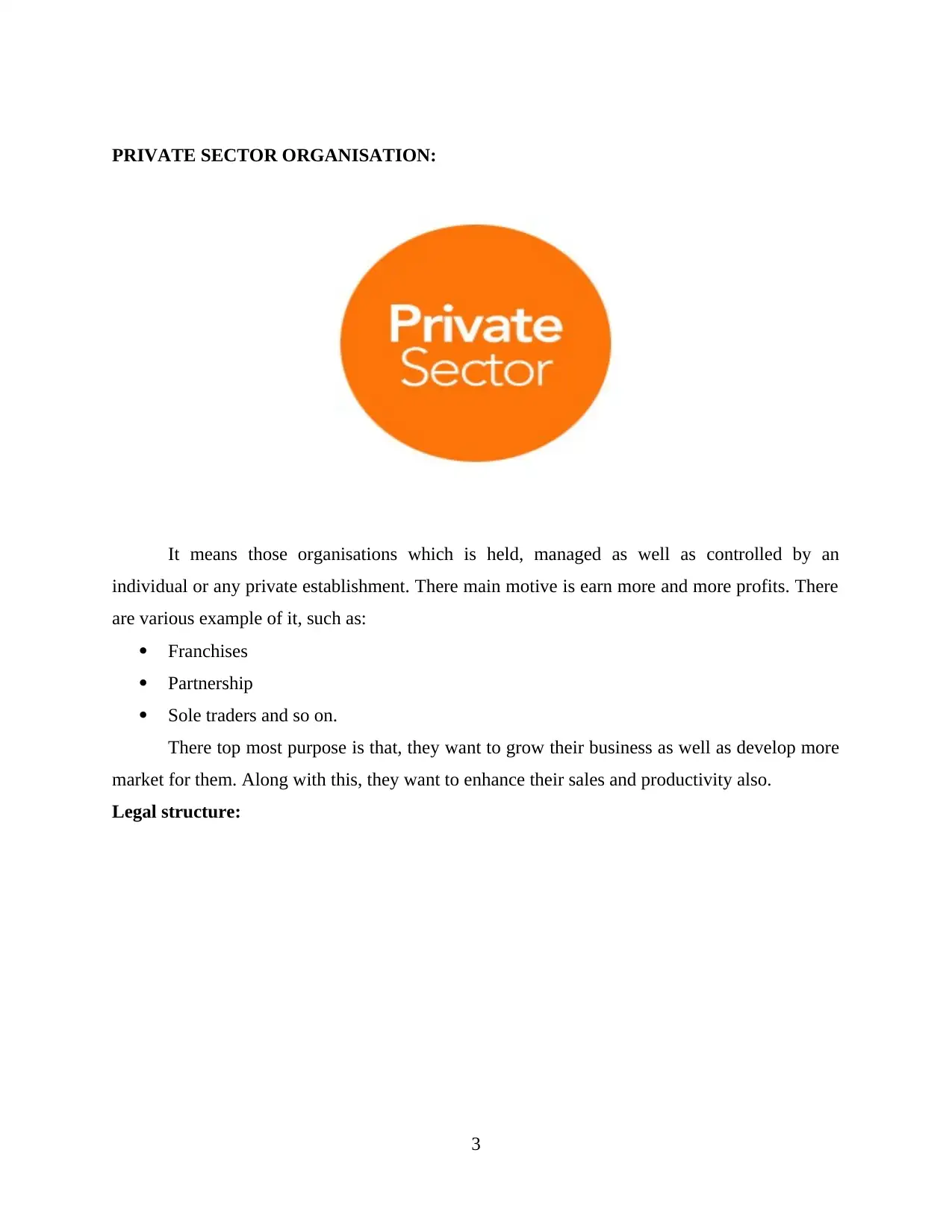
PRIVATE SECTOR ORGANISATION:
It means those organisations which is held, managed as well as controlled by an
individual or any private establishment. There main motive is earn more and more profits. There
are various example of it, such as:
Franchises
Partnership
Sole traders and so on.
There top most purpose is that, they want to grow their business as well as develop more
market for them. Along with this, they want to enhance their sales and productivity also.
Legal structure:
3
It means those organisations which is held, managed as well as controlled by an
individual or any private establishment. There main motive is earn more and more profits. There
are various example of it, such as:
Franchises
Partnership
Sole traders and so on.
There top most purpose is that, they want to grow their business as well as develop more
market for them. Along with this, they want to enhance their sales and productivity also.
Legal structure:
3
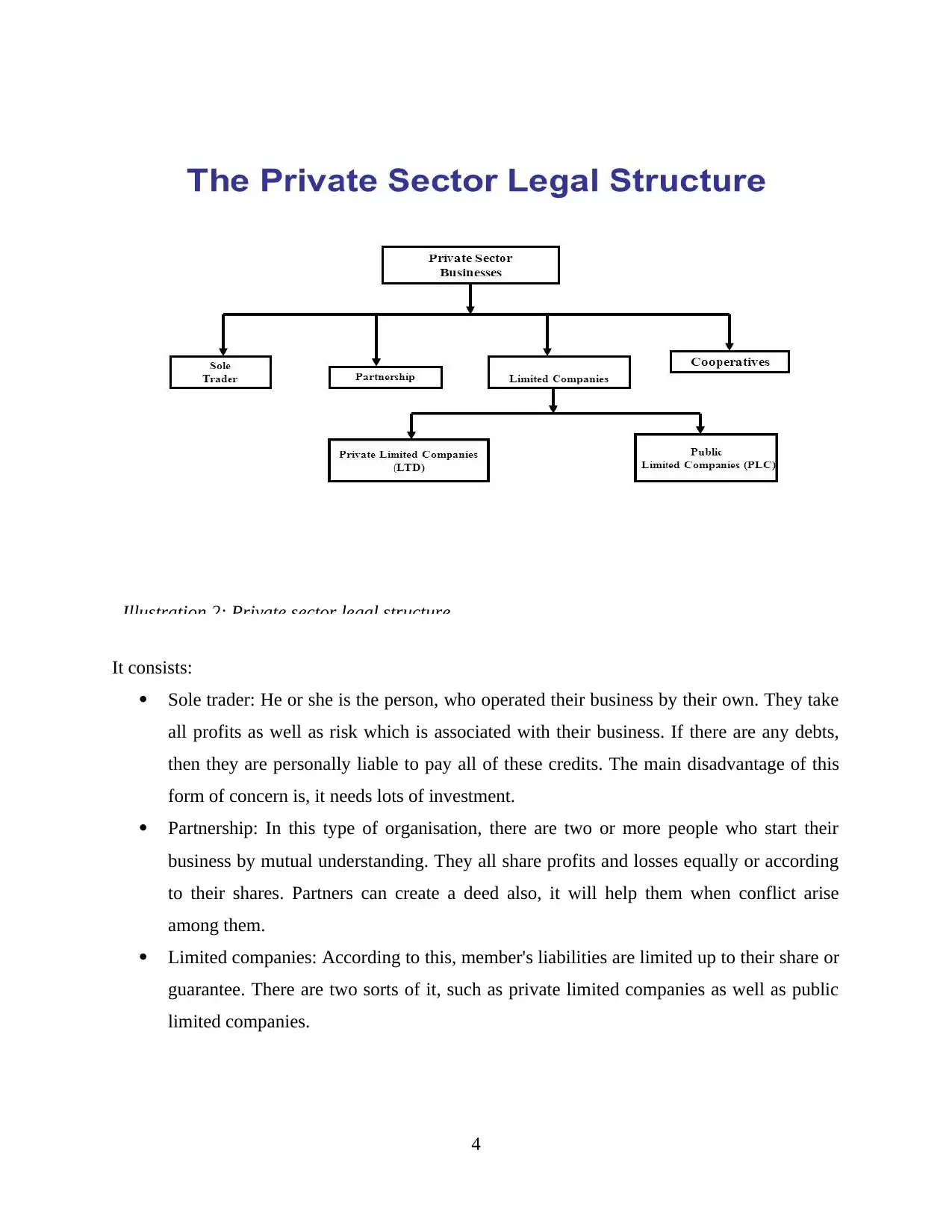
It consists:
Sole trader: He or she is the person, who operated their business by their own. They take
all profits as well as risk which is associated with their business. If there are any debts,
then they are personally liable to pay all of these credits. The main disadvantage of this
form of concern is, it needs lots of investment.
Partnership: In this type of organisation, there are two or more people who start their
business by mutual understanding. They all share profits and losses equally or according
to their shares. Partners can create a deed also, it will help them when conflict arise
among them.
Limited companies: According to this, member's liabilities are limited up to their share or
guarantee. There are two sorts of it, such as private limited companies as well as public
limited companies.
4
Illustration 2: Private sector legal structure
Sole trader: He or she is the person, who operated their business by their own. They take
all profits as well as risk which is associated with their business. If there are any debts,
then they are personally liable to pay all of these credits. The main disadvantage of this
form of concern is, it needs lots of investment.
Partnership: In this type of organisation, there are two or more people who start their
business by mutual understanding. They all share profits and losses equally or according
to their shares. Partners can create a deed also, it will help them when conflict arise
among them.
Limited companies: According to this, member's liabilities are limited up to their share or
guarantee. There are two sorts of it, such as private limited companies as well as public
limited companies.
4
Illustration 2: Private sector legal structure
⊘ This is a preview!⊘
Do you want full access?
Subscribe today to unlock all pages.

Trusted by 1+ million students worldwide
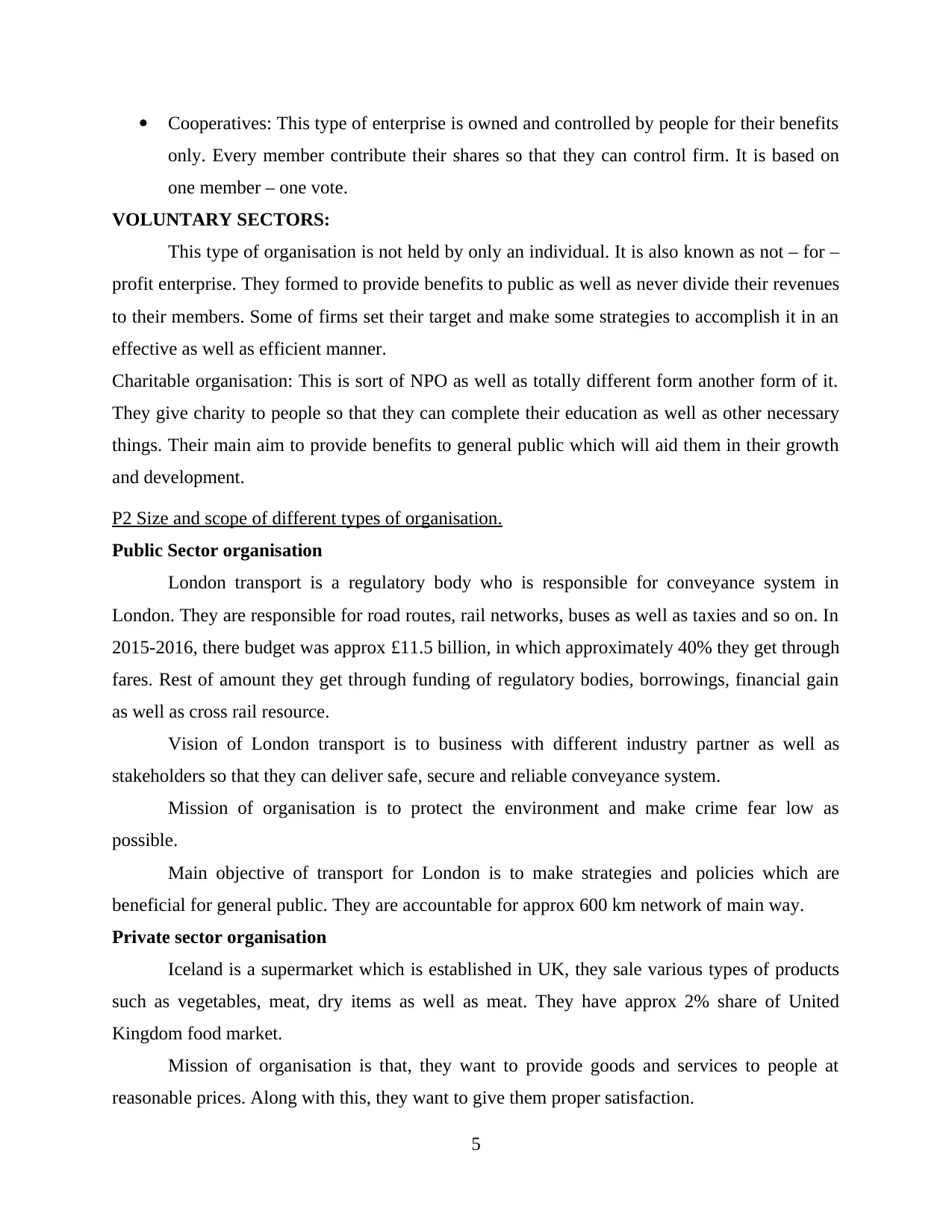
Cooperatives: This type of enterprise is owned and controlled by people for their benefits
only. Every member contribute their shares so that they can control firm. It is based on
one member – one vote.
VOLUNTARY SECTORS:
This type of organisation is not held by only an individual. It is also known as not – for –
profit enterprise. They formed to provide benefits to public as well as never divide their revenues
to their members. Some of firms set their target and make some strategies to accomplish it in an
effective as well as efficient manner.
Charitable organisation: This is sort of NPO as well as totally different form another form of it.
They give charity to people so that they can complete their education as well as other necessary
things. Their main aim to provide benefits to general public which will aid them in their growth
and development.
P2 Size and scope of different types of organisation.
Public Sector organisation
London transport is a regulatory body who is responsible for conveyance system in
London. They are responsible for road routes, rail networks, buses as well as taxies and so on. In
2015-2016, there budget was approx £11.5 billion, in which approximately 40% they get through
fares. Rest of amount they get through funding of regulatory bodies, borrowings, financial gain
as well as cross rail resource.
Vision of London transport is to business with different industry partner as well as
stakeholders so that they can deliver safe, secure and reliable conveyance system.
Mission of organisation is to protect the environment and make crime fear low as
possible.
Main objective of transport for London is to make strategies and policies which are
beneficial for general public. They are accountable for approx 600 km network of main way.
Private sector organisation
Iceland is a supermarket which is established in UK, they sale various types of products
such as vegetables, meat, dry items as well as meat. They have approx 2% share of United
Kingdom food market.
Mission of organisation is that, they want to provide goods and services to people at
reasonable prices. Along with this, they want to give them proper satisfaction.
5
only. Every member contribute their shares so that they can control firm. It is based on
one member – one vote.
VOLUNTARY SECTORS:
This type of organisation is not held by only an individual. It is also known as not – for –
profit enterprise. They formed to provide benefits to public as well as never divide their revenues
to their members. Some of firms set their target and make some strategies to accomplish it in an
effective as well as efficient manner.
Charitable organisation: This is sort of NPO as well as totally different form another form of it.
They give charity to people so that they can complete their education as well as other necessary
things. Their main aim to provide benefits to general public which will aid them in their growth
and development.
P2 Size and scope of different types of organisation.
Public Sector organisation
London transport is a regulatory body who is responsible for conveyance system in
London. They are responsible for road routes, rail networks, buses as well as taxies and so on. In
2015-2016, there budget was approx £11.5 billion, in which approximately 40% they get through
fares. Rest of amount they get through funding of regulatory bodies, borrowings, financial gain
as well as cross rail resource.
Vision of London transport is to business with different industry partner as well as
stakeholders so that they can deliver safe, secure and reliable conveyance system.
Mission of organisation is to protect the environment and make crime fear low as
possible.
Main objective of transport for London is to make strategies and policies which are
beneficial for general public. They are accountable for approx 600 km network of main way.
Private sector organisation
Iceland is a supermarket which is established in UK, they sale various types of products
such as vegetables, meat, dry items as well as meat. They have approx 2% share of United
Kingdom food market.
Mission of organisation is that, they want to provide goods and services to people at
reasonable prices. Along with this, they want to give them proper satisfaction.
5
Paraphrase This Document
Need a fresh take? Get an instant paraphrase of this document with our AI Paraphraser
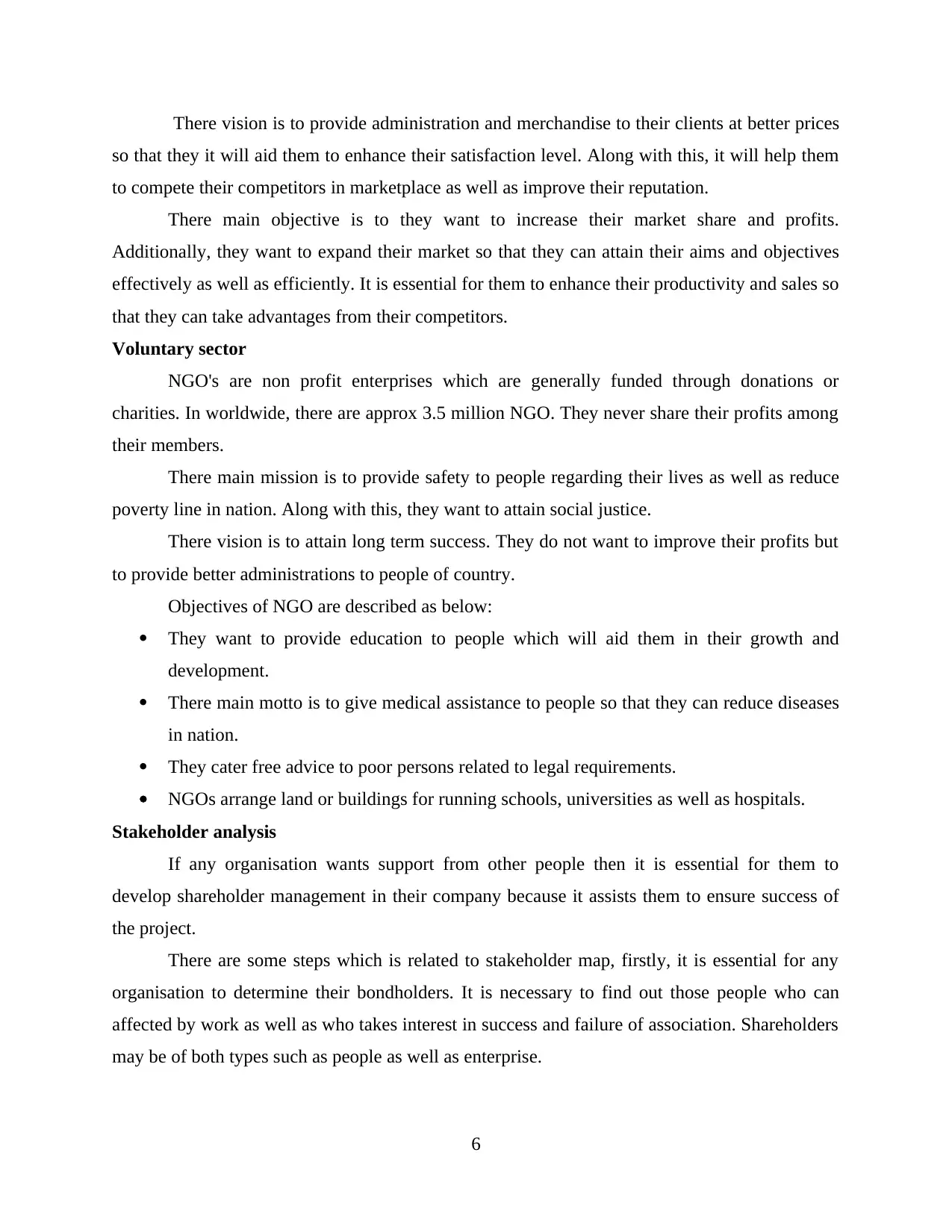
There vision is to provide administration and merchandise to their clients at better prices
so that they it will aid them to enhance their satisfaction level. Along with this, it will help them
to compete their competitors in marketplace as well as improve their reputation.
There main objective is to they want to increase their market share and profits.
Additionally, they want to expand their market so that they can attain their aims and objectives
effectively as well as efficiently. It is essential for them to enhance their productivity and sales so
that they can take advantages from their competitors.
Voluntary sector
NGO's are non profit enterprises which are generally funded through donations or
charities. In worldwide, there are approx 3.5 million NGO. They never share their profits among
their members.
There main mission is to provide safety to people regarding their lives as well as reduce
poverty line in nation. Along with this, they want to attain social justice.
There vision is to attain long term success. They do not want to improve their profits but
to provide better administrations to people of country.
Objectives of NGO are described as below:
They want to provide education to people which will aid them in their growth and
development.
There main motto is to give medical assistance to people so that they can reduce diseases
in nation.
They cater free advice to poor persons related to legal requirements.
NGOs arrange land or buildings for running schools, universities as well as hospitals.
Stakeholder analysis
If any organisation wants support from other people then it is essential for them to
develop shareholder management in their company because it assists them to ensure success of
the project.
There are some steps which is related to stakeholder map, firstly, it is essential for any
organisation to determine their bondholders. It is necessary to find out those people who can
affected by work as well as who takes interest in success and failure of association. Shareholders
may be of both types such as people as well as enterprise.
6
so that they it will aid them to enhance their satisfaction level. Along with this, it will help them
to compete their competitors in marketplace as well as improve their reputation.
There main objective is to they want to increase their market share and profits.
Additionally, they want to expand their market so that they can attain their aims and objectives
effectively as well as efficiently. It is essential for them to enhance their productivity and sales so
that they can take advantages from their competitors.
Voluntary sector
NGO's are non profit enterprises which are generally funded through donations or
charities. In worldwide, there are approx 3.5 million NGO. They never share their profits among
their members.
There main mission is to provide safety to people regarding their lives as well as reduce
poverty line in nation. Along with this, they want to attain social justice.
There vision is to attain long term success. They do not want to improve their profits but
to provide better administrations to people of country.
Objectives of NGO are described as below:
They want to provide education to people which will aid them in their growth and
development.
There main motto is to give medical assistance to people so that they can reduce diseases
in nation.
They cater free advice to poor persons related to legal requirements.
NGOs arrange land or buildings for running schools, universities as well as hospitals.
Stakeholder analysis
If any organisation wants support from other people then it is essential for them to
develop shareholder management in their company because it assists them to ensure success of
the project.
There are some steps which is related to stakeholder map, firstly, it is essential for any
organisation to determine their bondholders. It is necessary to find out those people who can
affected by work as well as who takes interest in success and failure of association. Shareholders
may be of both types such as people as well as enterprise.
6
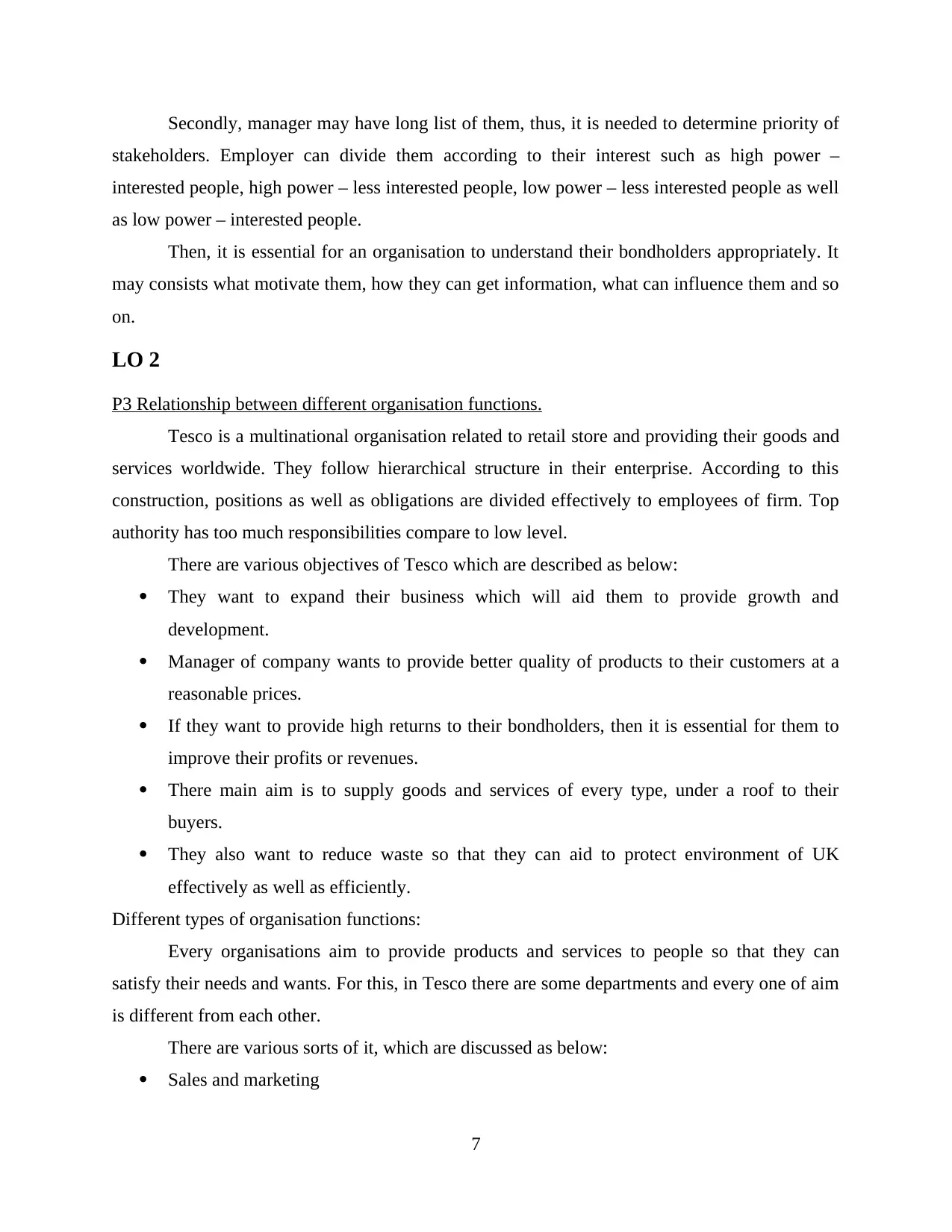
Secondly, manager may have long list of them, thus, it is needed to determine priority of
stakeholders. Employer can divide them according to their interest such as high power –
interested people, high power – less interested people, low power – less interested people as well
as low power – interested people.
Then, it is essential for an organisation to understand their bondholders appropriately. It
may consists what motivate them, how they can get information, what can influence them and so
on.
LO 2
P3 Relationship between different organisation functions.
Tesco is a multinational organisation related to retail store and providing their goods and
services worldwide. They follow hierarchical structure in their enterprise. According to this
construction, positions as well as obligations are divided effectively to employees of firm. Top
authority has too much responsibilities compare to low level.
There are various objectives of Tesco which are described as below:
They want to expand their business which will aid them to provide growth and
development.
Manager of company wants to provide better quality of products to their customers at a
reasonable prices.
If they want to provide high returns to their bondholders, then it is essential for them to
improve their profits or revenues.
There main aim is to supply goods and services of every type, under a roof to their
buyers.
They also want to reduce waste so that they can aid to protect environment of UK
effectively as well as efficiently.
Different types of organisation functions:
Every organisations aim to provide products and services to people so that they can
satisfy their needs and wants. For this, in Tesco there are some departments and every one of aim
is different from each other.
There are various sorts of it, which are discussed as below:
Sales and marketing
7
stakeholders. Employer can divide them according to their interest such as high power –
interested people, high power – less interested people, low power – less interested people as well
as low power – interested people.
Then, it is essential for an organisation to understand their bondholders appropriately. It
may consists what motivate them, how they can get information, what can influence them and so
on.
LO 2
P3 Relationship between different organisation functions.
Tesco is a multinational organisation related to retail store and providing their goods and
services worldwide. They follow hierarchical structure in their enterprise. According to this
construction, positions as well as obligations are divided effectively to employees of firm. Top
authority has too much responsibilities compare to low level.
There are various objectives of Tesco which are described as below:
They want to expand their business which will aid them to provide growth and
development.
Manager of company wants to provide better quality of products to their customers at a
reasonable prices.
If they want to provide high returns to their bondholders, then it is essential for them to
improve their profits or revenues.
There main aim is to supply goods and services of every type, under a roof to their
buyers.
They also want to reduce waste so that they can aid to protect environment of UK
effectively as well as efficiently.
Different types of organisation functions:
Every organisations aim to provide products and services to people so that they can
satisfy their needs and wants. For this, in Tesco there are some departments and every one of aim
is different from each other.
There are various sorts of it, which are discussed as below:
Sales and marketing
7
⊘ This is a preview!⊘
Do you want full access?
Subscribe today to unlock all pages.

Trusted by 1+ million students worldwide
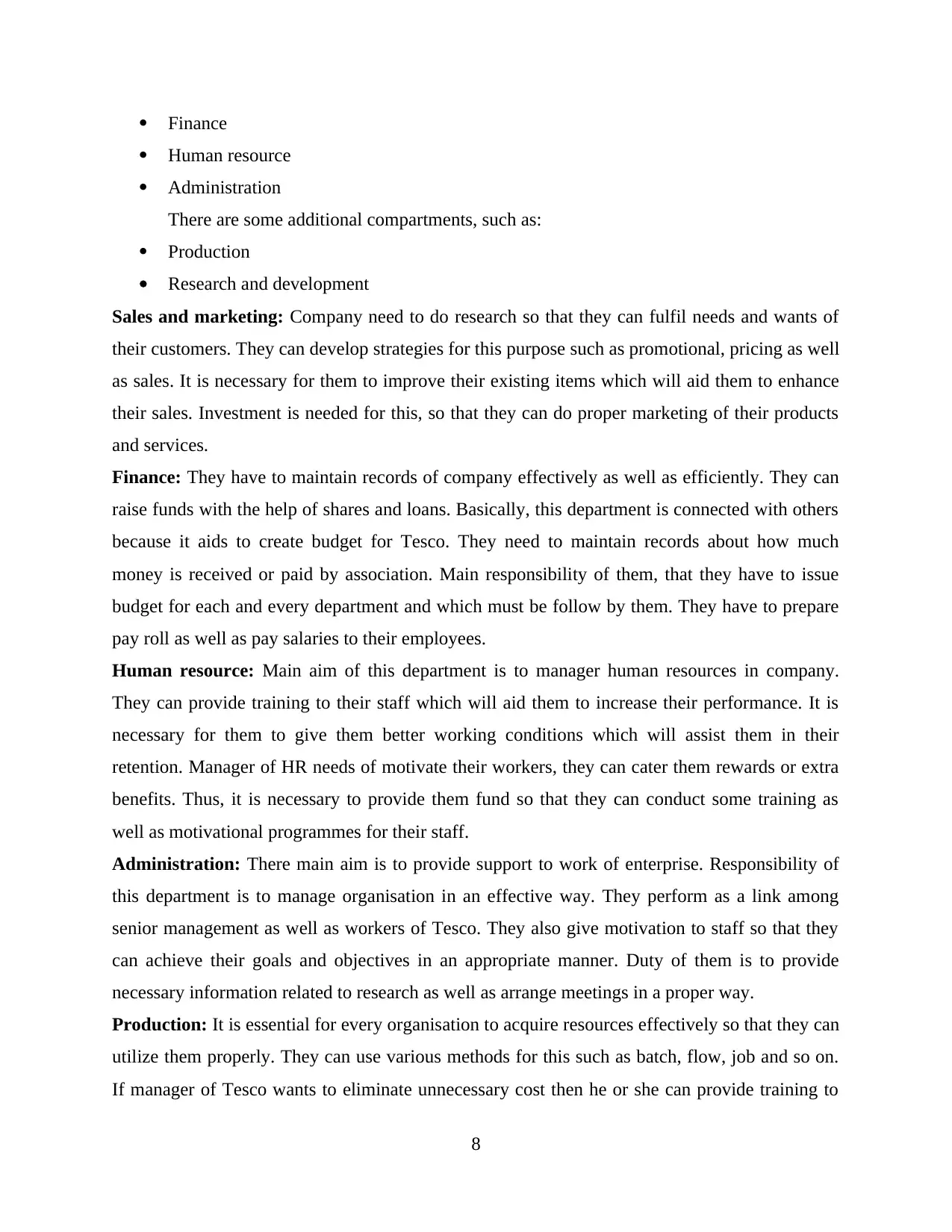
Finance
Human resource
Administration
There are some additional compartments, such as:
Production
Research and development
Sales and marketing: Company need to do research so that they can fulfil needs and wants of
their customers. They can develop strategies for this purpose such as promotional, pricing as well
as sales. It is necessary for them to improve their existing items which will aid them to enhance
their sales. Investment is needed for this, so that they can do proper marketing of their products
and services.
Finance: They have to maintain records of company effectively as well as efficiently. They can
raise funds with the help of shares and loans. Basically, this department is connected with others
because it aids to create budget for Tesco. They need to maintain records about how much
money is received or paid by association. Main responsibility of them, that they have to issue
budget for each and every department and which must be follow by them. They have to prepare
pay roll as well as pay salaries to their employees.
Human resource: Main aim of this department is to manager human resources in company.
They can provide training to their staff which will aid them to increase their performance. It is
necessary for them to give them better working conditions which will assist them in their
retention. Manager of HR needs of motivate their workers, they can cater them rewards or extra
benefits. Thus, it is necessary to provide them fund so that they can conduct some training as
well as motivational programmes for their staff.
Administration: There main aim is to provide support to work of enterprise. Responsibility of
this department is to manage organisation in an effective way. They perform as a link among
senior management as well as workers of Tesco. They also give motivation to staff so that they
can achieve their goals and objectives in an appropriate manner. Duty of them is to provide
necessary information related to research as well as arrange meetings in a proper way.
Production: It is essential for every organisation to acquire resources effectively so that they can
utilize them properly. They can use various methods for this such as batch, flow, job and so on.
If manager of Tesco wants to eliminate unnecessary cost then he or she can provide training to
8
Human resource
Administration
There are some additional compartments, such as:
Production
Research and development
Sales and marketing: Company need to do research so that they can fulfil needs and wants of
their customers. They can develop strategies for this purpose such as promotional, pricing as well
as sales. It is necessary for them to improve their existing items which will aid them to enhance
their sales. Investment is needed for this, so that they can do proper marketing of their products
and services.
Finance: They have to maintain records of company effectively as well as efficiently. They can
raise funds with the help of shares and loans. Basically, this department is connected with others
because it aids to create budget for Tesco. They need to maintain records about how much
money is received or paid by association. Main responsibility of them, that they have to issue
budget for each and every department and which must be follow by them. They have to prepare
pay roll as well as pay salaries to their employees.
Human resource: Main aim of this department is to manager human resources in company.
They can provide training to their staff which will aid them to increase their performance. It is
necessary for them to give them better working conditions which will assist them in their
retention. Manager of HR needs of motivate their workers, they can cater them rewards or extra
benefits. Thus, it is necessary to provide them fund so that they can conduct some training as
well as motivational programmes for their staff.
Administration: There main aim is to provide support to work of enterprise. Responsibility of
this department is to manage organisation in an effective way. They perform as a link among
senior management as well as workers of Tesco. They also give motivation to staff so that they
can achieve their goals and objectives in an appropriate manner. Duty of them is to provide
necessary information related to research as well as arrange meetings in a proper way.
Production: It is essential for every organisation to acquire resources effectively so that they can
utilize them properly. They can use various methods for this such as batch, flow, job and so on.
If manager of Tesco wants to eliminate unnecessary cost then he or she can provide training to
8
Paraphrase This Document
Need a fresh take? Get an instant paraphrase of this document with our AI Paraphraser
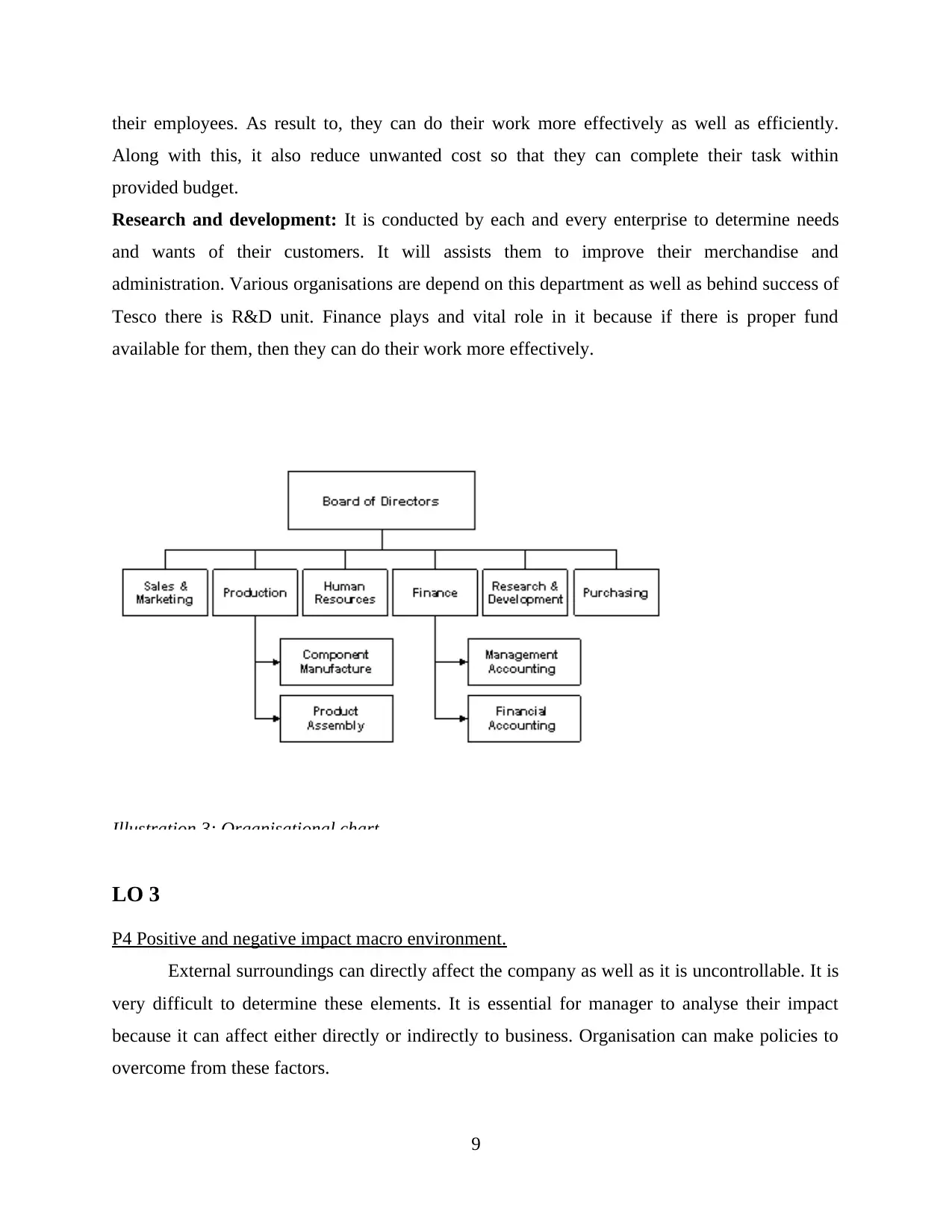
their employees. As result to, they can do their work more effectively as well as efficiently.
Along with this, it also reduce unwanted cost so that they can complete their task within
provided budget.
Research and development: It is conducted by each and every enterprise to determine needs
and wants of their customers. It will assists them to improve their merchandise and
administration. Various organisations are depend on this department as well as behind success of
Tesco there is R&D unit. Finance plays and vital role in it because if there is proper fund
available for them, then they can do their work more effectively.
Illustration 3: Organisational chart
LO 3
P4 Positive and negative impact macro environment.
External surroundings can directly affect the company as well as it is uncontrollable. It is
very difficult to determine these elements. It is essential for manager to analyse their impact
because it can affect either directly or indirectly to business. Organisation can make policies to
overcome from these factors.
9
Along with this, it also reduce unwanted cost so that they can complete their task within
provided budget.
Research and development: It is conducted by each and every enterprise to determine needs
and wants of their customers. It will assists them to improve their merchandise and
administration. Various organisations are depend on this department as well as behind success of
Tesco there is R&D unit. Finance plays and vital role in it because if there is proper fund
available for them, then they can do their work more effectively.
Illustration 3: Organisational chart
LO 3
P4 Positive and negative impact macro environment.
External surroundings can directly affect the company as well as it is uncontrollable. It is
very difficult to determine these elements. It is essential for manager to analyse their impact
because it can affect either directly or indirectly to business. Organisation can make policies to
overcome from these factors.
9
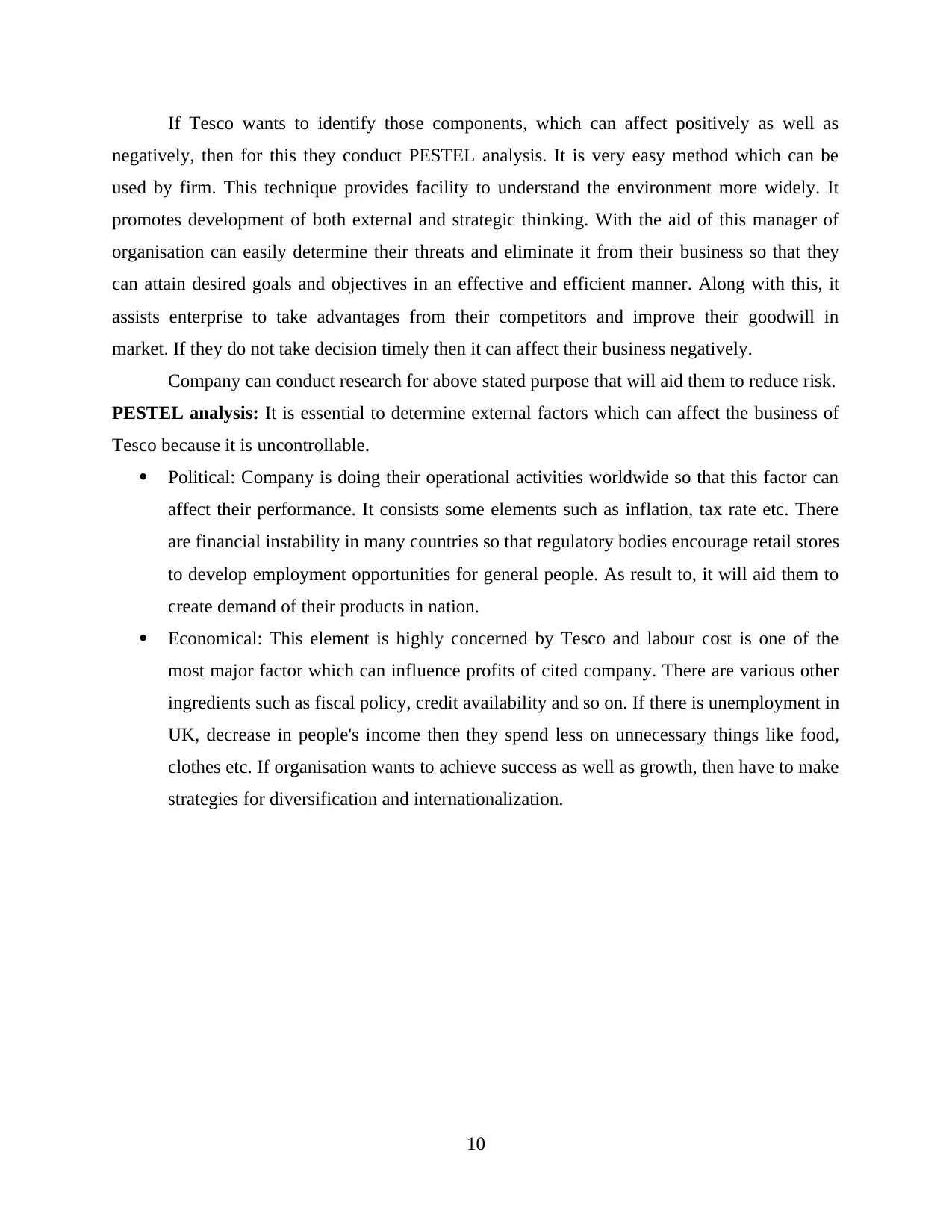
If Tesco wants to identify those components, which can affect positively as well as
negatively, then for this they conduct PESTEL analysis. It is very easy method which can be
used by firm. This technique provides facility to understand the environment more widely. It
promotes development of both external and strategic thinking. With the aid of this manager of
organisation can easily determine their threats and eliminate it from their business so that they
can attain desired goals and objectives in an effective and efficient manner. Along with this, it
assists enterprise to take advantages from their competitors and improve their goodwill in
market. If they do not take decision timely then it can affect their business negatively.
Company can conduct research for above stated purpose that will aid them to reduce risk.
PESTEL analysis: It is essential to determine external factors which can affect the business of
Tesco because it is uncontrollable.
Political: Company is doing their operational activities worldwide so that this factor can
affect their performance. It consists some elements such as inflation, tax rate etc. There
are financial instability in many countries so that regulatory bodies encourage retail stores
to develop employment opportunities for general people. As result to, it will aid them to
create demand of their products in nation.
Economical: This element is highly concerned by Tesco and labour cost is one of the
most major factor which can influence profits of cited company. There are various other
ingredients such as fiscal policy, credit availability and so on. If there is unemployment in
UK, decrease in people's income then they spend less on unnecessary things like food,
clothes etc. If organisation wants to achieve success as well as growth, then have to make
strategies for diversification and internationalization.
10
negatively, then for this they conduct PESTEL analysis. It is very easy method which can be
used by firm. This technique provides facility to understand the environment more widely. It
promotes development of both external and strategic thinking. With the aid of this manager of
organisation can easily determine their threats and eliminate it from their business so that they
can attain desired goals and objectives in an effective and efficient manner. Along with this, it
assists enterprise to take advantages from their competitors and improve their goodwill in
market. If they do not take decision timely then it can affect their business negatively.
Company can conduct research for above stated purpose that will aid them to reduce risk.
PESTEL analysis: It is essential to determine external factors which can affect the business of
Tesco because it is uncontrollable.
Political: Company is doing their operational activities worldwide so that this factor can
affect their performance. It consists some elements such as inflation, tax rate etc. There
are financial instability in many countries so that regulatory bodies encourage retail stores
to develop employment opportunities for general people. As result to, it will aid them to
create demand of their products in nation.
Economical: This element is highly concerned by Tesco and labour cost is one of the
most major factor which can influence profits of cited company. There are various other
ingredients such as fiscal policy, credit availability and so on. If there is unemployment in
UK, decrease in people's income then they spend less on unnecessary things like food,
clothes etc. If organisation wants to achieve success as well as growth, then have to make
strategies for diversification and internationalization.
10
⊘ This is a preview!⊘
Do you want full access?
Subscribe today to unlock all pages.

Trusted by 1+ million students worldwide
1 out of 21
Related Documents
Your All-in-One AI-Powered Toolkit for Academic Success.
+13062052269
info@desklib.com
Available 24*7 on WhatsApp / Email
![[object Object]](/_next/static/media/star-bottom.7253800d.svg)
Unlock your academic potential
Copyright © 2020–2025 A2Z Services. All Rights Reserved. Developed and managed by ZUCOL.





